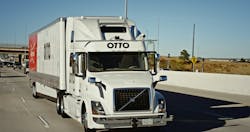WEB EXCLUSIVE: Transportation revolution
By: Shailen P. Bhatt
Less than 10 years ago, smartphones revolutionized how we communicate, how we work and how we interact with others. Just a few years ago, the concept of hailing an Uber car to take you where you needed within minutes was relatively unheard of. Technology is rapidly changing our lives, but there has not been a monumental change in everyday transportation since the early 1900s when cars began to be mass-produced and affordable for the average American. Access to cars completely changed our country and how we travel—and now we are at the beginning of our next transportation revolution, thanks to technology.
It is unlikely a person born today will learn how to manually drive a vehicle. Major automakers are moving quickly to embed driver-assistance technology into vehicles and develop fully self-driving vehicles. I believe it is the responsibility of every department of transportation to work hand-in-hand with the private sector to ensure that these technology-transformed vehicles are not working independently, but are connected to a transportation and infrastructure system that is secure and protected from cyber threats. At the Colorado Department of Transportation (CDOT), we have launched RoadX, our vision and commitment to embrace innovative technology to transform transportation across our state—leading to travel that is free of crashes, injuries and delays.
Why RoadX?
In Colorado, we likely face many of the same transportation and infrastructure challenges as other states—we are low on funding, our population is booming, congestion is hurting our economy and crashes are leading to thousands of traffic injuries and fatalities. We know we cannot just build our way out of these issues. With RoadX, CDOT is pursuing a connected future that not only could reduce crashes by 80%, but also improve the capacity of our existing highways. We are working toward that connected future now, pursuing projects that deliver:
- Improved, localized driving, safety and navigation apps using real-time data;
- Connected vehicles and drivers with the capacity to “talk” to each other, helping to prevent crashes and improve the flow of traffic;
- Smarter trucking that moves goods and services more efficiently, for the benefit of communities and industry;
- Improved, smarter systems in infrastructure, like intelligent ramps that help improve the flow of traffic and decrease the need for additional lanes;
- Infrastructure that “talks” to cars, like smart pavement or virtual guardrails, to prevent and eliminate crashes; and
- Infrastructure that improves sustainability of our environment such as developing inductive charging in roadways to support electric vehicles.
For each of these projects, CDOT is committed to ensuring that the data and systems used are secure and protected against cyber attacks that could result in theft of personal information or disruption of services. Cyber security is key to the success of the RoadX program.
How can it be done?
You may be asking, “How can a state DOT possibly have the expertise and funding to accomplish these complicated initiatives?” We looked to the experts that have just as much stake in the game as a government organization does—the private sector. From its inception, RoadX has focused on partnering with private industry to pursue innovative ideas and tap into their expertise to ensure technologies are securely deployed. We are committed to making Colorado the state where industry demonstrates and deploys technology that will revolutionize travel. Simply put, we have told the private sector: “We have the will and the infrastructure. You have the ideas and the tools. Colorado is open for business.”
In just the last year, we have developed partnerships with major industry players, including:
- OTTO—we partnered with OTTO to complete the world’s first commercial delivery by a self-driving truck;
- Panasonic—together we are building a replicable platform for connected transportation where vehicles and infrastructure share instantaneous data and information about road and safety conditions; and
- HERE—on I-70 through the Colorado Rockies, one of the most geographically challenging corridors in the nation, we are pursuing cellular connected-vehicle technology to provide drivers with access to the most real-time data possible to help them make better-informed decisions while traveling.
While we are still in the early years of RoadX, we are moving full steam ahead with embracing technology. Allow me to dive a little deeper into some of the major projects CDOT is working on and successes we have already experienced.
Current projects and initiatives
OTTO and CDOT—Pursuing autonomous commercial deliveries
In October of this year, we had the opportunity to partner with OTTO and make history, completing the world’s first commercial delivery by a self-driving truck. I got to join the convoy that monitored the truck, and I can honestly say it was one of the most exciting and boring things I have ever experienced. From the outside, it looked just like another semi driving down the highway, except this one stayed right in the middle of its lane for the entire 120-mile journey. It had to respond to things every other vehicle on the road had to—slowdowns due to traffic, vehicles passing and merging in front of it, and curves in the road—and it did so seamlessly.
By demonstrating that self-driving trucking is not only possible, but also safe, we are getting closer to a reality of smarter trucking. Soon we will have self-driving trucks that can platoon and drive within inches of each other to reduce wind resistance and increase fuel efficiency. If trucks can drive themselves and just be monitored by someone in the vehicle, they can travel during the night or early morning, reducing the impact on highways during commuting hours. More efficient trucking could even mean lower prices for consumers.
While this was just a single demonstration, we plan to continue working with OTTO and others to deploy this technology, and truly transform the trucking industry and improve safety on our roadways.
Smart 70 — Connected-vehicle technology deployment in the mountains
If you’ve ever driven on I-70 in the winter through the mountains in Colorado, you know how challenging that corridor can be. One moment it is clear skies and dry roads, and the next you are in the middle of a snowstorm with reduced visibility and slick conditions. It is also one of the most heavily traveled corridors in the state, with recreational travel on weekends sometimes hitting peaks of more than 50,000 vehicles in a single day as people head to up to ski and snowboard during the winter or hike and camp in the summer. Current plans to improve the I-70 Mountain corridor with roadway and transit improvements range between $3 billion to $20 billion. With an annual budget of only $1 billion, innovative technology could allow us to deploy cost-effective solutions to address mountain travel congestion.
We are combining our partnerships with Panasonic and HERE to create our Smart 70 project—to first deploy cellular connected-vehicle technology, and soon after deploy dedicated short-range communications (DSRC) technology to provide real-time information directly to drivers in a secure manner. The idea is that there is an incredible amount of data that is possible to collect, and by consolidating that data into a comprehensive single platform that does not identify any specific individual information about the vehicle or driver, we will be able to effectively and safely inform drivers, and eventually the self-driving systems, about what they are approaching and how to drive more effectively and safety. This data sharing can also help our maintenance crews and snow plows work more efficiently.
Imagine a world where your tires slip on the road, and an alert is immediately sent to a connected transportation platform, informing other drivers of the icy area and allowing CDOT to deploy plows exactly to that location. Or when a crash occurs, you get alerted to which, if any, lanes are closed, how many vehicles are involved, and receive updates about which lane you should drive in and what speed you should travel to stay safe. Imagine a world, now, where the data is ingested by a self-driving system, augmenting the radars, maps and cameras so the vehicle responds even more accurately to what is on the road. That is the world we are approaching, with estimates of up to four million connected vehicles in Colorado in the next 10 years. And if the Smart 70 connected-vehicle platform can work on the I-70 Mountain Corridor, we think it will be replicable anywhere.
Smart 25 — Connecting Colorado and Australia to reduce commuting congestion
Sometimes you have to look to other countries for examples of transformative technology, and even work with them to deploy that technology here. That is exactly what we are doing along I-25 in Denver, our main commuter highway connecting communities to the Denver-metro area. In Melbourne, Australia, a system called “Managed Motorways” was developed to turn an existing “dumb” freeway into a “smarter,” more connected system that maximized roadway volume and managed speeds. The main element of the new system was “smart” on- and off-ramp metering that held vehicles for slightly longer periods before entering and exiting the highway, so as to maximize the capacity of every lane.
The results were significant—a 25% increase in throughput during peak periods in each direction, the equivalent of adding one additional lane to the highway; a 50% reduction in overall travel delays; and a 2050% reduction in crashes along some segments.
We have already started working to deploy a similar system along I-25 in Denver, dubbing it Smart 25. It involves the installation of roadway sensors to identify exactly how many vehicles are in each lane and how quickly they are traveling. That information is sent to a secure system that looks at the entire corridor and immediately communicates with ramp meters about how quickly to allow vehicles to enter the highway safely and maintain a consistent speed throughout their trip, rather than enter the highway and hit a bottleneck. In good conditions, a single highway lane operating at 50 to 60 mph can pump through 1,800 vehicles per hour; if there are too many vehicles, speeds drop to 15 to 20 mph and throughput is reduced to 800900 vehicles per hour. Smart 25 should maximize that vehicle throughput on our existing highway, improving trip reliability and travel times, reducing crashes and creating more efficient travel for everyone.
At a cost of just around $7 million and with construction only taking several weeks, our Smart 25 project could have a huge return on investment when you consider the time lost by travelers who sit in stop-and-go traffic or compared to the cost of expanding the highway and paving a new lane (up to $500$650 million).
Not there yet, but getting close
Exploring innovative technologies is a great start, but we will not truly revolutionize travel until we have a widespread, interconnected system that not only links drivers, vehicles and infrastructure, but does so in a manner that protects against cyber threats. With our projects in Colorado, we are developing them in a way to hopefully become the standard for deployment in other states. We are working on the policies and regulations that support innovation and are protective of our travelers. We also are working to build a replicable system that will not only benefit Colorado, but the entire country.
And in the spirit of innovation, if you have an idea that you would like to pursue in Colorado, please do not hesitate to reach out to us at roadx.codot.gov. It is going to take a lot of brain power, creativity and initiative to truly launch the transportation revolution that is possible.
About The Author: Bhatt is executive director of the Colorado Department of Transportation




